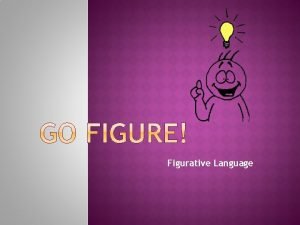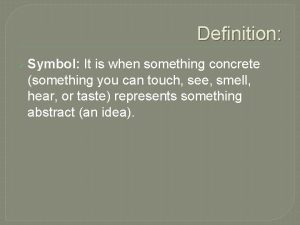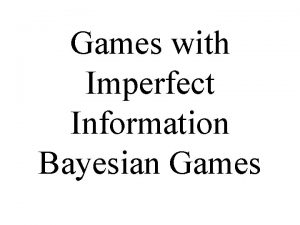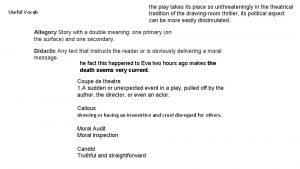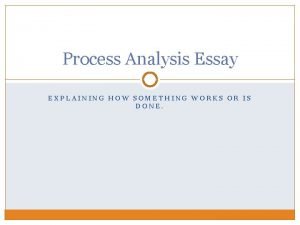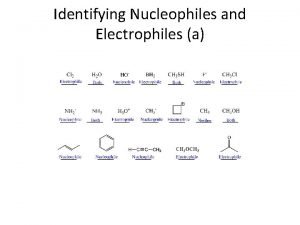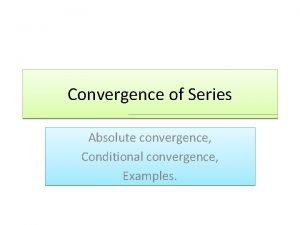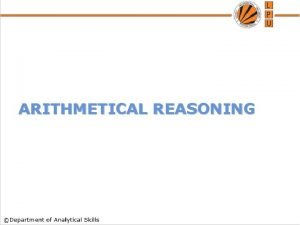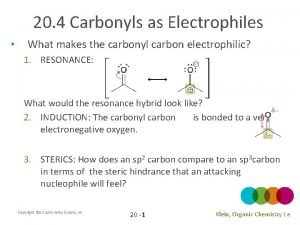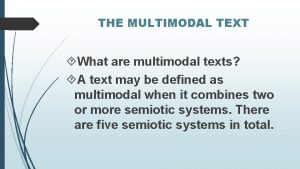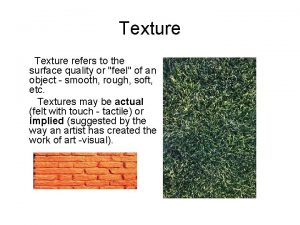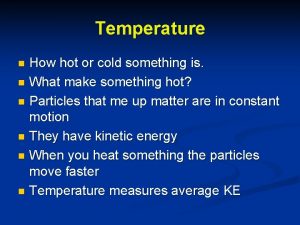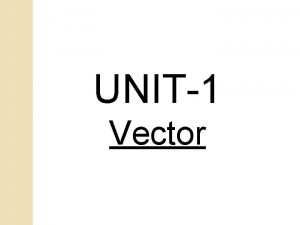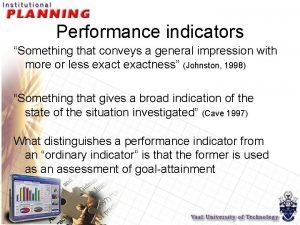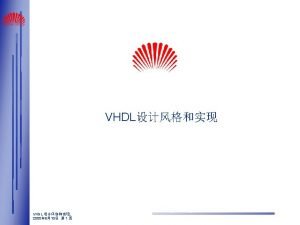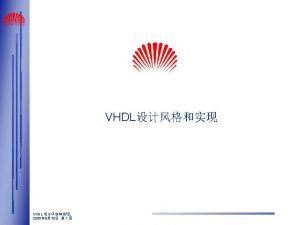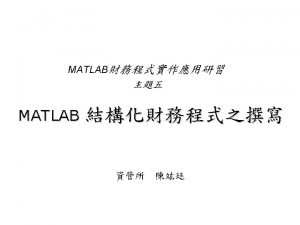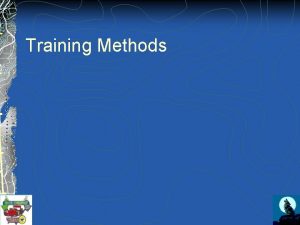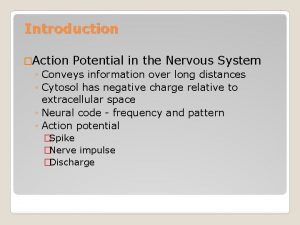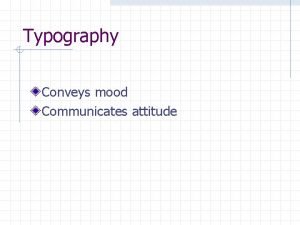UNIT1 INTRODUCTION Introduction u Signal something conveys information









![Basic Sequences u. Exponential sequences u. A and α are real: x[n] is real Basic Sequences u. Exponential sequences u. A and α are real: x[n] is real](https://slidetodoc.com/presentation_image_h2/627fcd77273b07cffabc4eb45de15d9f/image-10.jpg)









![Properties of Discrete-time systems Memoryless (memory) system u. Memoryless systems: the output y[n] at Properties of Discrete-time systems Memoryless (memory) system u. Memoryless systems: the output y[n] at](https://slidetodoc.com/presentation_image_h2/627fcd77273b07cffabc4eb45de15d9f/image-20.jpg)













![Computation of the Convolution (interpretation 2) ureflecting h[k] about the origion to obtain h[-k] Computation of the Convolution (interpretation 2) ureflecting h[k] about the origion to obtain h[-k]](https://slidetodoc.com/presentation_image_h2/627fcd77273b07cffabc4eb45de15d9f/image-34.jpg)

![Convolution can be realized by –Reflecting h[k] about the origin to obtain h[-k]. –Shifting Convolution can be realized by –Reflecting h[k] about the origin to obtain h[-k]. –Shifting](https://slidetodoc.com/presentation_image_h2/627fcd77273b07cffabc4eb45de15d9f/image-36.jpg)
![Properties of LTI Systems u. Convolution is commutative(可交换的) x[n] h[n] y[n] h[n] x[n] y[n] Properties of LTI Systems u. Convolution is commutative(可交换的) x[n] h[n] y[n] h[n] x[n] y[n]](https://slidetodoc.com/presentation_image_h2/627fcd77273b07cffabc4eb45de15d9f/image-37.jpg)
![Cascade connection of systems x [ n] h 1[ n] h 2[ n] y Cascade connection of systems x [ n] h 1[ n] h 2[ n] y](https://slidetodoc.com/presentation_image_h2/627fcd77273b07cffabc4eb45de15d9f/image-38.jpg)




















- Slides: 58

UNIT-1 INTRODUCTION

Introduction u Signal: something conveys information u Signals are represented mathematically as functions of one or more independent variables. u Continuous-time (analog) signals, discrete-time signals, digital signals u Signal-processing systems are classified along the same lines as signals: Continuous-time (analog) systems, discrete-time systems, digital systems u Discrete-time signal u Sampling a continuous-time signal u Generated directly by some discrete-time process

2. 1 Discrete-Time Signals: Sequences u. Discrete-Time signals are represented as Cumbersome, so just use u. In sampling, u 1/T (reciprocal of T) : sampling frequency

Figure : Graphical representation of a discrete-time signal Abscissa: continuous line : is defined only at discrete instants

EXAMPLE Sampling the analog waveform Figure 2

Basic Sequence Operations u. Sum of two sequences u. Product of two sequences u. Multiplication of a sequence by a numberα u. Delay (shift) of a sequence

Basic sequences u. Unit sample sequence (discrete-time impulse, impulse)

Basic sequences A sum of scaled, delayed impulses uarbitrary sequence

Basic sequences u. Unit step sequence First backward difference
![Basic Sequences u Exponential sequences u A and α are real xn is real Basic Sequences u. Exponential sequences u. A and α are real: x[n] is real](https://slidetodoc.com/presentation_image_h2/627fcd77273b07cffabc4eb45de15d9f/image-10.jpg)
Basic Sequences u. Exponential sequences u. A and α are real: x[n] is real u. A is positive and 0<α<1, x[n] is positive and decrease with increasing n u-1<α<0, x[n] alternate in sign, but decrease in magnitude with increasing n u : x[n] grows in magnitude as n increases 6/9/2021

EX. Combining Basic sequences u. If we want an exponential sequences that is zero for n <0, then Cumbersome simpler 11

Basic sequences u. Sinusoidal sequence 12

Exponential Sequences Exponentially weighted sinusoids Exponentially growing envelope Exponentially decreasing envelope is refered to Complex Exponential Sequences 13

Frequency difference between continuous-time and discrete-time complex exponentials or sinusoids u : frequency of the complex sinusoid or complex exponential u : phase

Periodic Sequences u. A periodic sequence with integer period N

EX. Examples of Periodic Sequences u. Suppose it is periodic sequence with period N 16

EX. Examples of Periodic Sequences u. Suppose it is periodic sequence with period N

EX. Non-Periodic Sequences u. Suppose it is periodic sequence with period N

Discrete-Time System u. Discrete-Time System is a trasformation or operator that maps input sequence x[n] into a unique y[n] uy[n]=T{x[n]}, x[n], y[n]: discrete-time signal x[n] T{‧} y[n] Discrete-Time System.
![Properties of Discretetime systems Memoryless memory system u Memoryless systems the output yn at Properties of Discrete-time systems Memoryless (memory) system u. Memoryless systems: the output y[n] at](https://slidetodoc.com/presentation_image_h2/627fcd77273b07cffabc4eb45de15d9f/image-20.jpg)
Properties of Discrete-time systems Memoryless (memory) system u. Memoryless systems: the output y[n] at every value of n depends only on the input x[n] at the same value of n 20

Properties of Discrete-time systems Linear Systems u. If T{‧} uand only If: additivity property T{‧} homogeneity or scaling 同(齐)次性 property T{‧} uprinciple of superposition T{‧} 21

Example of Linear System u. Ex. Accumulator system for arbitrary when 22

Properties of Discrete-time systems Time-Invariant Systems u. Shift-Invariant Systems T{‧} 23

Example of Time-Invariant System u. Ex. Accumulator system 24

Example of Time-varying System u. Ex. 2. 9 The compressor system T{‧} 0 0 T{‧} 0 25 0

Properties of Discrete-time systems Causality u. A system is causal if, for every choice of , the output sequence value at the index depends only on the input sequence value for 26

Ex. Example for Causal System u. Forward difference system is not Causal u. Backward difference system is Causal 27

Properties of Discrete-time systems Stability u. Bounded-Input Bounded-Output (BIBO) Stability: every bounded input sequence produces a bounded output sequence. if then 28 .

Ex. Test for Stability or Instability is stable if then 29

Ex. Test for Stability or Instability u. Accumulator system is not stable 30 .

Linear Time-Invariant (LTI) Systems u. Impulse response T{‧} 31

LTI Systems: Convolution u. Representation of general sequence as a linear combination of delayed impulse uprinciple of superposition An Illustration Example(interpretation 1). 32

33 6/9/2021 Zhongguo Liu_Biomedical Engineering_Shandong Univ.
![Computation of the Convolution interpretation 2 ureflecting hk about the origion to obtain hk Computation of the Convolution (interpretation 2) ureflecting h[k] about the origion to obtain h[-k]](https://slidetodoc.com/presentation_image_h2/627fcd77273b07cffabc4eb45de15d9f/image-34.jpg)
Computation of the Convolution (interpretation 2) ureflecting h[k] about the origion to obtain h[-k] u. Shifting the origin of the reflected sequence to k=n 34 .

Ex. 35 6/9/2021 Zhongguo Liu_Biomedical Engineering_Shandong Univ.
![Convolution can be realized by Reflecting hk about the origin to obtain hk Shifting Convolution can be realized by –Reflecting h[k] about the origin to obtain h[-k]. –Shifting](https://slidetodoc.com/presentation_image_h2/627fcd77273b07cffabc4eb45de15d9f/image-36.jpg)
Convolution can be realized by –Reflecting h[k] about the origin to obtain h[-k]. –Shifting the origin of the reflected sequences to k=n. –Computing the weighted moving average of x[k] by using the weights given by h[n-k]. 36
![Properties of LTI Systems u Convolution is commutative可交换的 xn hn yn hn xn yn Properties of LTI Systems u. Convolution is commutative(可交换的) x[n] h[n] y[n] h[n] x[n] y[n]](https://slidetodoc.com/presentation_image_h2/627fcd77273b07cffabc4eb45de15d9f/image-37.jpg)
Properties of LTI Systems u. Convolution is commutative(可交换的) x[n] h[n] y[n] h[n] x[n] y[n] u. Convolution is distributed over addition 37
![Cascade connection of systems x n h 1 n h 2 n y Cascade connection of systems x [ n] h 1[ n] h 2[ n] y](https://slidetodoc.com/presentation_image_h2/627fcd77273b07cffabc4eb45de15d9f/image-38.jpg)
Cascade connection of systems x [ n] h 1[ n] h 2[ n] y [ n] x [ n] h 2[ n] h 1[ n] y [ n] x [ n] 38 h 1[n] ] h 2[n] y [ n]

Parallel connection of systems 39

Stability of LTI Systems u. LTI system is stable if the impulse response is absolutely summable. Causality of LTI systems 40

Impulse response of LTI systems u. Impulse response of Ideal Delay systems u. Impulse response of Accumulator 41

u. Impulse response of Forward Difference u. Impulse response of Backward Difference 42

Linear Constant-Coefficient Difference Equations u. An important subclass of linear timeinvariant systems consist of those system for which the input x[n] and output y[n] satisfy an Nth-order linear constant-coefficient difference equation. 43

Ex. Difference Equation Representation of the Accumulator 44

Block diagram of a recursive difference equation representing an accumulator 45

Difference Equation Representation of the System u. An unlimited number of distinct difference equations can be used to represent a given linear time-invariant input-output relation. 46

Solving the difference equation u. Without additional constraints or information, a linear constantcoefficient difference equation for discrete-time systems does not provide a unique specification of the output for a given input. 47

Solving the difference equation u. Output: u Particular solution: one output sequence for the given input u Homogenous solution: solution for the homogenous equation( ): u where 48 is the roots of

Solving the difference equation recursively u. If the input and a set of auxiliary value are specified. y(n) can be written in a recurrence formula: 49

Fourier Transform rectangular form 50 polar form

Impulse response and Frequency response u. The frequency response of a LTI system is the Fourier transform of the impulse response. 51

Fourier Transform Theorems u. Linearity 52

Fourier Transform Theorems u. Time shifting and frequency shifting

Fourier Transform Theorems u. Time reversal u. If is real,

Fourier Transform Theorems u. Differentiation in Frequency 55

Fourier Transform Theorems u. Parseval’s Theorem u is called the energy density spectrum

Fourier Transform Theorems u. Convolution Theorem if

Fourier Transform Theorems u. Modulation or Windowing Theorem
 Slidetodoc.com
Slidetodoc.com What does candy's dog symbolize
What does candy's dog symbolize Explanation purpose
Explanation purpose Smart is something you become not something you are
Smart is something you become not something you are The room is an oven figurative language
The room is an oven figurative language Theme vs topic
Theme vs topic When something represents something else
When something represents something else Something old something new poem
Something old something new poem Is adjective a language feature
Is adjective a language feature Unity of mood means
Unity of mood means Baseband signal and bandpass signal
Baseband signal and bandpass signal Baseband signal and bandpass signal
Baseband signal and bandpass signal Digital signal as a composite analog signal
Digital signal as a composite analog signal Classification of signal
Classification of signal Phrases signal example
Phrases signal example Complete vs perfect information
Complete vs perfect information Never leave home without it
Never leave home without it What makes something newsworthy
What makes something newsworthy How do you know something is alive?
How do you know something is alive? What is historically significant
What is historically significant Is density how heavy something is
Is density how heavy something is Image of something
Image of something Unit 6 the passive have something done
Unit 6 the passive have something done Mr birling irresponsible quotes
Mr birling irresponsible quotes The merchant of venice act 4
The merchant of venice act 4 How to write a synthesis essay
How to write a synthesis essay Taking something that doesn't belong to you
Taking something that doesn't belong to you West side story tritone
West side story tritone Something bother you
Something bother you What are the six types of simple machines
What are the six types of simple machines Something was wrong kenzie
Something was wrong kenzie How something works
How something works To cause someone to believe something
To cause someone to believe something Determinants of personality
Determinants of personality Percentage
Percentage 40 something cowgirls
40 something cowgirls Identifying electrophiles and nucleophiles
Identifying electrophiles and nucleophiles Memorize things quickly
Memorize things quickly Unit 46 have something done
Unit 46 have something done Name something kids
Name something kids Trust, faith, or confidence in someone or something
Trust, faith, or confidence in someone or something I need a fact that something i can prove
I need a fact that something i can prove Elegy poem form
Elegy poem form Conditionally convergent series examples
Conditionally convergent series examples So be your name buxbaum
So be your name buxbaum Given signs signify something
Given signs signify something What makes something electrophilic
What makes something electrophilic What is multimodal text
What is multimodal text Texture refers to
Texture refers to A text structure that describes something
A text structure that describes something The measure of how hot or cold something is
The measure of how hot or cold something is Indefinite pronouns examples
Indefinite pronouns examples Something wicked this way comes chapter summaries
Something wicked this way comes chapter summaries Something evil this way comes macbeth
Something evil this way comes macbeth Something upstairs
Something upstairs Something better than in the middle
Something better than in the middle Somewhere anywhere somebody anybody something anything
Somewhere anywhere somebody anybody something anything It is the arrangement of something into different groups
It is the arrangement of something into different groups To make someone do something
To make someone do something




